Hillside Farm Hawaii
Grooming Fuzzy Bunnies
Micro-sheep! Yarn fiber on the hoof!
Well, they don't really have hooves, but other than that these bunnies are like little micro-sheep. How does all that fuzzy bunny become exquisite yarn? That is their purpose, after all and we will try to answer that question although the yarn spinning will be on a different page of this website.
Well, to start with, you need an angora bunny. Then you have this absurdly cute fuzzy bunny who is absolutely adorable and nibbles on leaves and is fun to watch, but now what? How do you help the poor fuzzy critter keep it's wool organized into something soft and fuzzy and not a matted mess? How does that become yarn? Guess I need to add in some pages about spinning fluff into yarn, but first we will work on organizing the fluff. Angora bunnies need help keeping themselves fluffy, they can't do it on their own. Angoras were never a breed of wild bunny, they have always been domesticated. Shootz! They can't even really breed properly without a haircut. That would really limit their survival capabilities in the wild, now wouldn't it? Not to mention not really being able to see predators all that well past the wool over their faces.
There are also some health issues if they aren't groomed. Angora bunnies can get 'wool block' which is when they ingest too many long hairs while grooming themselves. That can create a blockage in their innards and then they essentially starve to death because they can't digest anything.
Grooming the bunnies not only keeps them healthy but it provides us with some insanely nice fiber. A definite 'win-win' the way I see it.
This is what we are trying to prevent!
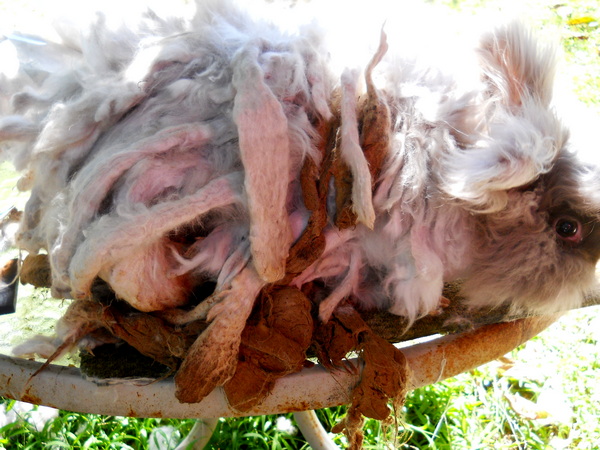 ~
~
Angora Bunny in extreme need of grooming
The bunny in the picture is the one in the worst need of grooming that I've ever seen. She showed up here several years ago for some extreme grooming. It looked like she hadn't been groomed for at least a full year if possibly not more. At this level of matted coat, I'm surprised she survived and was still able to move around enough to eat. She also had a lot of mess on the bottom and there could have been the possibility of fly strike had things gone on much longer.
I tried teaching her people how to groom their bunny, but after finding out how much time and effort it took to get her coat back in order (and keep it that way), they decided to leave the bunny here at Hillside. As they found out, angora bunnies are not good pets, they're great "micro-sheep" though - that is, if you maintain their coats. But if you don't have any use for their wool, they're way too much work to have around so even though they're absurdly cute, especially when they're young and haven't grown out their full coat or after they've been groomed. Unless you want them for wool, they're going to be way too much work to keep tidy so find a different breed of bunny for a bunny companion. A mini-Rex would be my recommenation, they've got the really soft Rex fur and are a lot less maintenance.
It took about three hours to get most of the mess off of her, but we did find a bunny under all that. Since she hadn't been able to move very much after she got so terribly matted, the very under layer of wool hadn't matted too much so it had grown out a bit without becoming terribly matted and there was room to get the scissors in there to nip off the dreadlocks. She also got her nails trimmed, treated for ear and wool mites and seemed most appreciative of the whole thing. She didn't grumble about the long grooming session at all. Even though her coat had been a huge mess, after she was sheared and it was removed, the new coat grew in nicely.
There are several ways to keep an angora groomed, however, usually the first determination of how to groom your bunny is decide whether the bunny is a 'show' bunny or a 'fiber' bunny. If the rabbit is being groomed to be a show bunny, then probably most of the methods we use here at Hillside Farm will not be of much use for you. The bunnies here are for providing fiber for yarn, so we are more concerned with the quality of the fiber after it comes off the bunny than the quality of the fiber while it's on the bunny. There are other webpages out there with information on how to groom an angora bunny for shows, so I won't discuss that here since we've never done that type of grooming - mostly because we don't have a blower, though. I suspect if we had a blower we'd use it. But, because they get sheared, our bunnies don't and won't win any bunny show bigger than one of our local ones. They get the absolutely wrong kind of grooming if they were to be competitive at a big national bunny show.
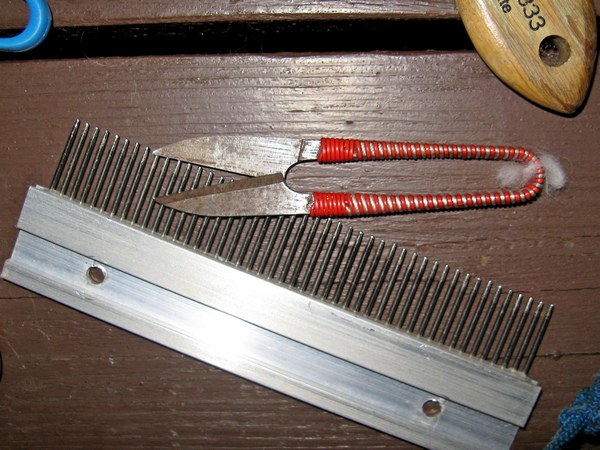 ~
~
Basic grooming tools used here
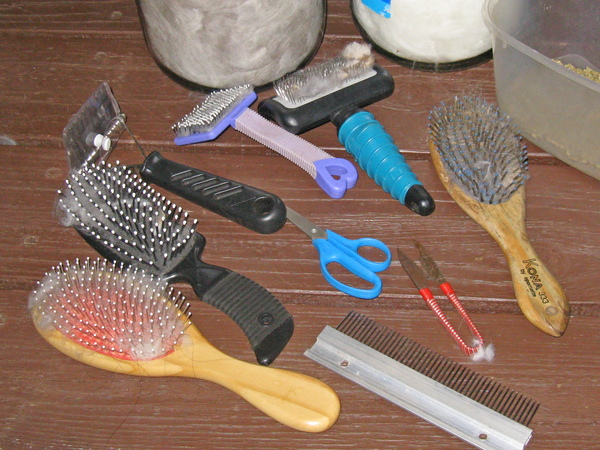 ~
~
assortment of brushes we've tried
The basic grooming tools which we use here probably more than any others is a long toothed steel comb. We also use a pair of embroidery snips for shearing and sometimes fingers to pull apart mats. The steel comb came from the horse section at the feed store where they have all the grooming tools for horse's manes and tails. The snips shown in the picture are actually steel snips for bonsai although there are very similar ones at the fabric shop which are used for snipping threads.
We have the 'molting' type of English angoras, so a lot of their fiber can be harvested by 'plucking'. That's when the outer layer of the coat that is molting off can be pulled off with the fingers. It's a lot like when your dog or cat is molting, the hairs come right off. If you can pinch a little bit of the outer coat and it easily comes off, then the coat is ready to be harvested by plucking. Plucking is probably the easiest way to harvest the coat although it's not the quickest. Basically, get comfortable with the bunny and pull bits of the outer coat off. I'll usually start in one area and keep pulling bits out until the remaining coat doesn't pull off easily. It's usually much shorter so it's easy to tell when you've gotten the loose coat off. If you have a colored bunny, the coat that is ready to be harvested is generally the coat that is significantly lighter in color as well.
Over the years, we've tried all sorts of different grooming tools. Some have been more useful than others, but the ones which remain are the long toothed steel comb and scissors. The dog 'slicker' brushes aren't all that useful on the bunny, but they're great for getting the fibers off of us after a long grooming session. They're also useful for carding the fibers in preparation for spinning.
If the bunny's coat is not matted, then horse clippers work very well for getting the fiber off the bunny in a short amount of time. However, because the blades have very fine teeth, if the coat is too dense or has mats, then the clippers can't get in there. The clippers aren't useful for the entire bunny either, they're a bit too big to go around the delicate bunny bits. But, for getting the back and sides off quickly, they work pretty well - if everything is in a condition where they can work.
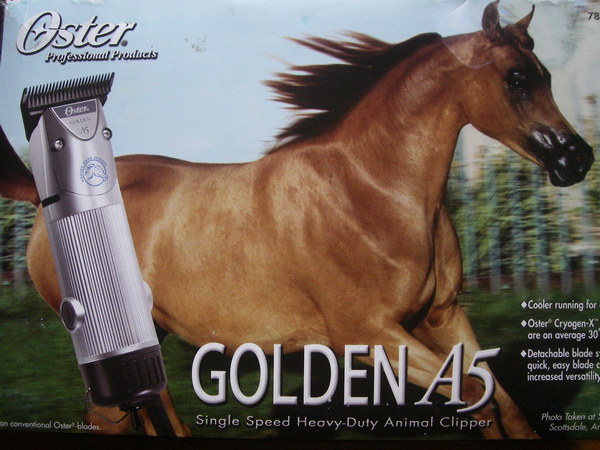 ~
~
Golden A5 Oster Horse clipper box
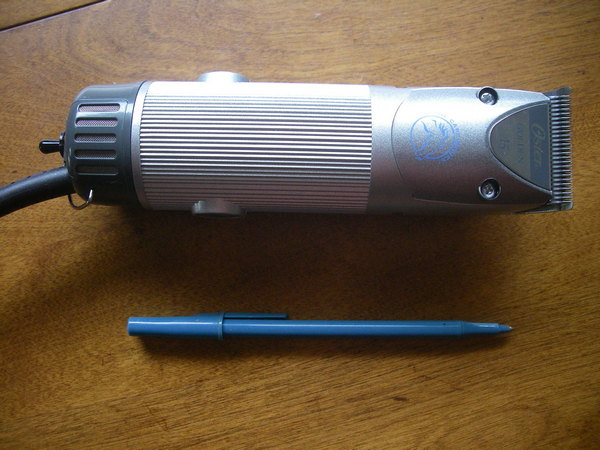 ~
~
Golden A5 Oster Horse clippers
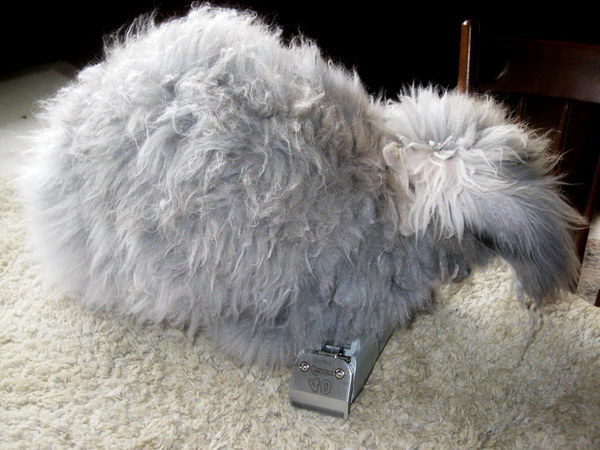 ~
~
Sydney inspecting the clippers
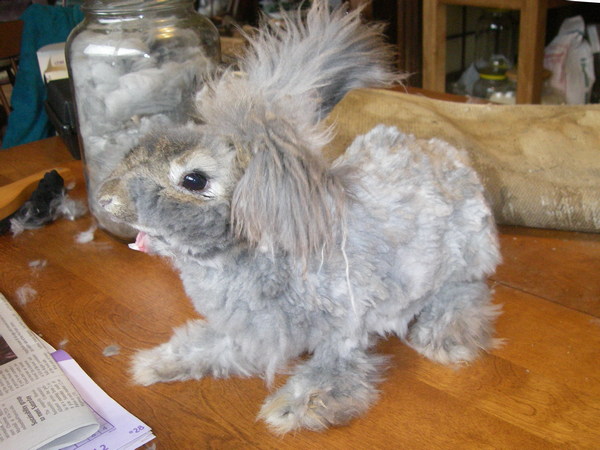 ~
~
Sydney laughing at his haircut
The Oster Golden A5 horse clippers with the #40 blade do work on angoras, although there is - well, "they" say there is - a better clipper out there. Searching for 'big red clipper angora bunny' would probably bring up more information on them since "Aesculap® German Red Clipper" is too hard to type into the search bar. They are supposed to be a better clipper, but at a much more expensive price as well. Since those clippers aren't available from our local feed store and these Oster clippers were, we opted for Oster's Golden A5. They do a good job when the coat is in good shape and not too dense and there's no mats. Once the coat does not fit within those parameters, then the clippers won't fit, either.
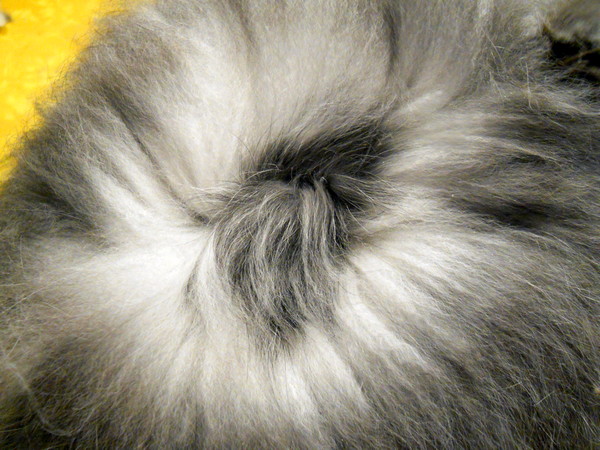 ~
~
Checking the coat before grooming
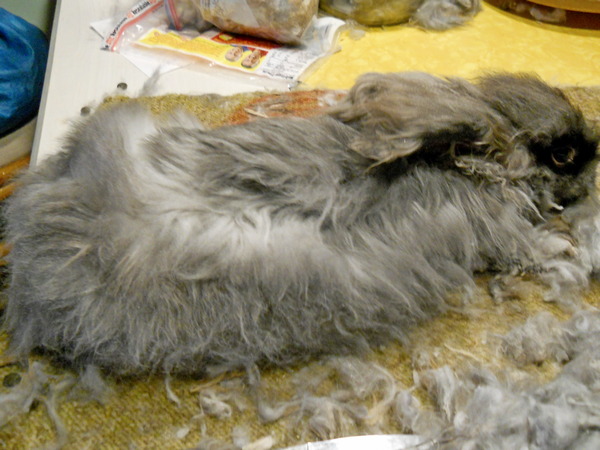 ~
~
Plucking instead of clipping
Before deciding which is the best method for grooming the bunny, it's nice to see what stage of hair growth their coat is in. Angora bunnies have several layers of coat on them at all times.
If the newest coat hasn't grown in much, then the existing coats can be harvested by clipping. If the new coming in coat is very long, though, then clipping may not be the best method since the little tips of the growing in coat will get clipped off as well. Those little short fibers in the yarn can cause little lumps and bumps which are called 'nits' when they're in the yarn. Not to be too nit picky, but we don't want nits to pick out.
This bunny is Zelda and she has her coming in coat too long to be clipped, so she's getting her coat harvested by plucking. Afterwards her coat will be shorter, but she will still have the growing in coat on her so this is also a good method for winter time coat maintenance when the bunnies would like to have a bit of coat for warmth.
General Scissors Trimming
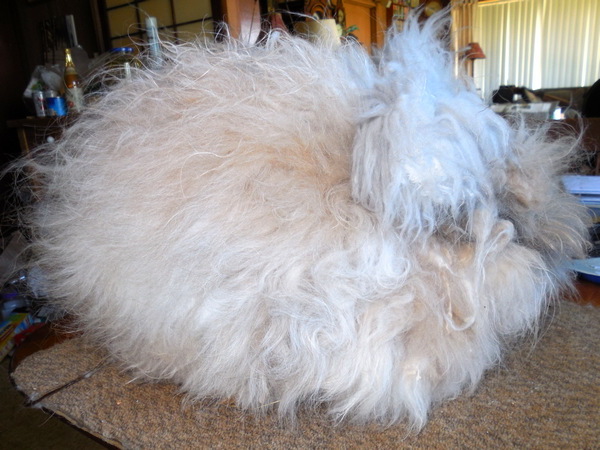 ~
~
Before a basic haircut
 ~
~
After a basic hair cut
This is probably how we do the majority of our grooming here at Hillside Farm. Even if we start the wool harvest by plucking, more often than not we will default to shearing with scissors since it's faster.
It used to be that we did most of the shearing here using the small embroidery snips or bonsai snips. They look just like micro-sized hand sheep shears and fit these 'micro-sheep' bunnies real well. However, they only snip a little bit at a time. Which is a good thing, if you're not absolutely certain about bunny anatomy. You really don't want to use bigger scissors until there's been some practice with tiny snips. Bunnies have very loose skin so until there's been some practice, it's quite possible to snip more than just the wool.
Once there is enough experience, we've found that barber's hair cutting scissors work really well for clipping bunny wool. The first ones we used were found at a yard sale and they were very inexpensive so we thought giving them a try with the bunnies would be a good experiment. The hair cutting scissors worked great for trimming bunny wool, but they are a bit scary as well since it would be quite possible to cut the bunny along with the wool.
Probably about 80% of the bunny haircuts around here are now done by barber's scissors. First off check the coat to see if it's the right timing for a scissors cut. Then trim the toenails so flying bunny feet won't make scratches. Then grab the barber's scissors or the embroidery snips, whichever one you feel most comfortable using.
Usually we start at the upper back and kinda lay over the wool to each side to reach the skin. When we can see the skin, then the snips or scissors are put in parallel to the bunny body and a narrow strip of wool is cut off. The wool is cut in long strips that are about quarter inch wide so it's easy to tell the location of the blade since they can be seen through the wool. Also if the back of the blade of the snips or scissors is against the bunny body at a ninety degree angle, there's less chance of getting bunny skin caught in the shearing process.
Once we get started on the back, we just keep taking strips off the side of the area where we started. Just keep going and eventually there will be a partially naked bunny. It isn't a fast process, so be patient.
Once we get to the undeside, more often than not, that will be done with the embroidery snips. They're smaller and fit better and there's a lot of delicate bits on the bottom of a bunny. Since English angoras grow wool EVERYWHERE, there's grooming on the underside as well as the topside. We usually leave their ears fluffy.
As far as bunny patience is concerned, they're not usually gonna like all the grooming but, hey, guess who's bigger than the bunny? When the bunnies here get sulky and difficult about being groomed, that's when we decide to turn them upside down and clip their toenails or groom the undercarriage. Ha! Then when they get turned back rightside up again, they're happy about being groomed again. Bunnies are quite trainable, but then, so are people so the training can go either way.
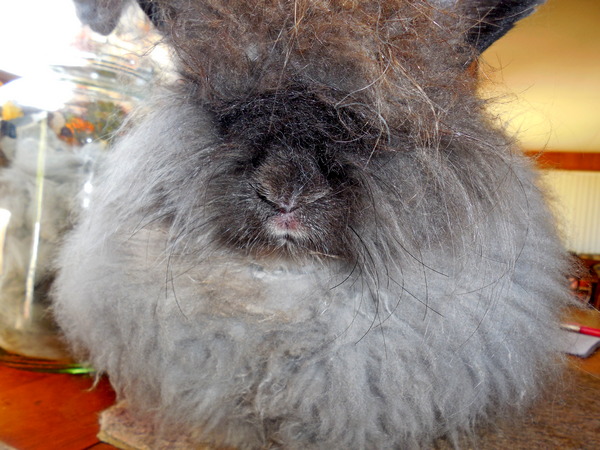 ~
~
Ready for a haircut
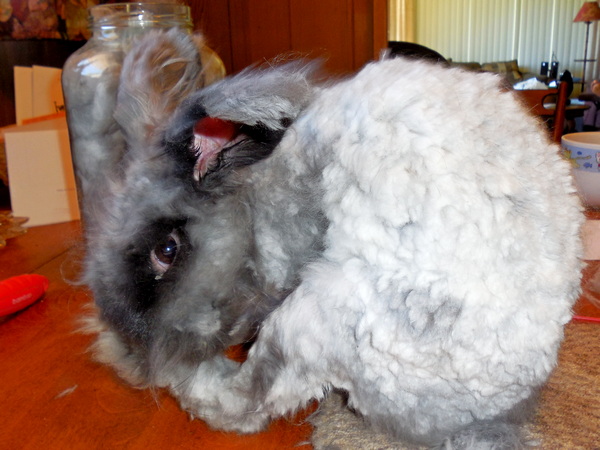 ~
~
finally getting to the itchy spots
The bunnies actually kinda like having their coats removed. Although they like it better after it's done than during the process so sometimes they will get a bit antsy during their groomings. If they wiggle too much, that's when they get turned upside down to get their toenails trimmed. Pretty soon they figure out that wiggling does not help and gets them turned upside down so they learn to behave well when being groomed.
To turn them upside down, one hand scoops under the bunny butt while the other lifts the chest and they get rolled onto their back. When they are first turned upside down, there will be an arm or a hand across them somewhat to keep them there until they settle down. Once they relax, then they will usually stay in that position on their own for quite awhile.
Bunnies can kick out with their feet and can twitch really fast, so always be aware of where their feet would go, should they suddenly kick out for whatever reason. A loud noise can scare them and if you're looking at them closely when they get alarmed and kick, the results could be less than optimum. Which is why it's also a good idea to trim toenails at the beginning of a grooming session instead of the end. They're gonna get trimmed anyway, may as well get them done before doing a lot of handling of the bunny.
A lot of times in the middle of a grooming session the bunny will realize that it is now possible to reach the itch that has been there for awhile. Sometimes the bunny tries to help in removing the coat and will start chewing on fur, too. Most of them like licking itchy spots on their sides after the coat is removed. They also look forward to the snuggles and then romping around without the coat on afterwards.
When you figure they're only a six pound bunny and we've just trimmed six or seven ounces of wool off of them, that's a pretty significant immediate weight loss. That means after a haircut they will hop around and it's a prime time for bunny binkies. A 'binky' is when a happy rabbit just has to jump up and usually twist around at the same time. It's a hoot to watch.
Several years ago PETA put out a video on angora wool being harvested by having the rabbits tied out like they were on a barbeque or something and then having their fur pulled off. While the rabbit is screaming, like any sensible critter would do in that situation. However, all that proves is that PETA is ignorant. First off, wool harvested in that fashion would ruin the animal for any successive wool harvests. It's kinda like cutting down the apple tree to harvest apples. You can only do it once and no apple farmer would ever do it that way. Same with harvesting angora fiber. So, obviously, that video put out by PETA is some sort of a really rude and bizarre thing that they either made themselves or someone else made it for some unknown reason. But, a lot of folks are not all that akamai (that's Hawaiian for 'wise' or 'knowing') so they believed the PETA video to be true. (And then the price of angora products dropped like a rock. So, who is buying the angora fiber and how much did they save?) Well, anyway, should you be interested in seeing some commercial angoras properly clipped in China using methods that allows for more wool harvests, here's a video link: Scissor Clipping Angoras in China. Much less dramatic than screaming bloody bunnies, but much more realistic, IMHO.
The type of angoras they are clipping in the video are the commercial type or as they are sometimes called, 'Chinese' angoras. They aren't a recognized breed by ARBA, but there's a lot of rabbit breeds that ARBA doesn't recognize. Anyway, the Chinese angoras are much larger than the English angoras that we have here and they are always white. I've heard they were bred from Giant and German angoras, but I forget where I heard it. Seems likely, though. The commercial angora fiber is different than the English angora fiber, too, not as soft as the English, but the harvesting method they use will also work on English angoras.
We haven't gotten to this level of fast when it comes to shearing the bunnies. They also leave quite a bit of the fiber on the bunny and there's what looks like a lot of 'second cuts'b but they do have amazing speed. 'Second cuts' are the short bits of fiber get cut off during the shearing process when the same area of wool is cut twice. Those little bits get tangled up in the wool being spun and make bumps in the yarn called 'neps', I believe. They also sometimes don't get thoroughly spun in and fall off which causes the yarn to 'shed'. It's best to not have the second cuts or take them out of the collected fiber if and when they happen.

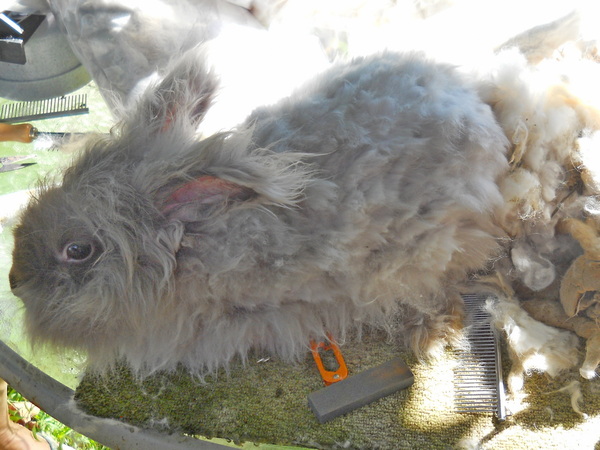
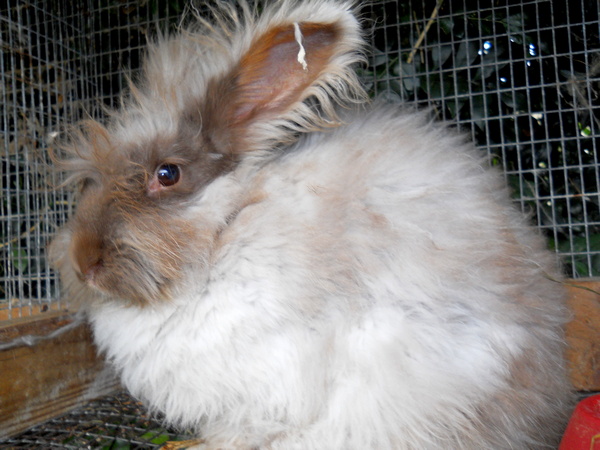
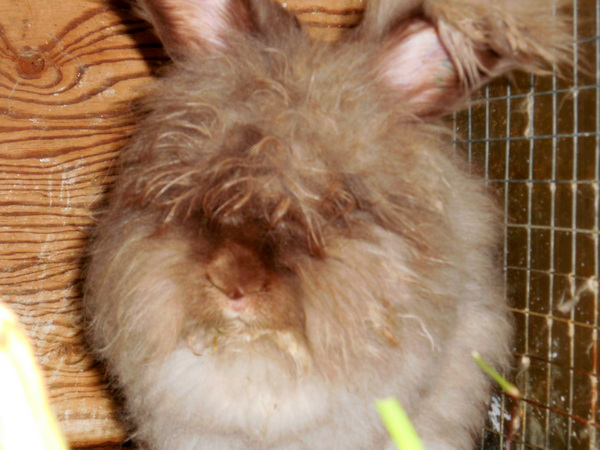
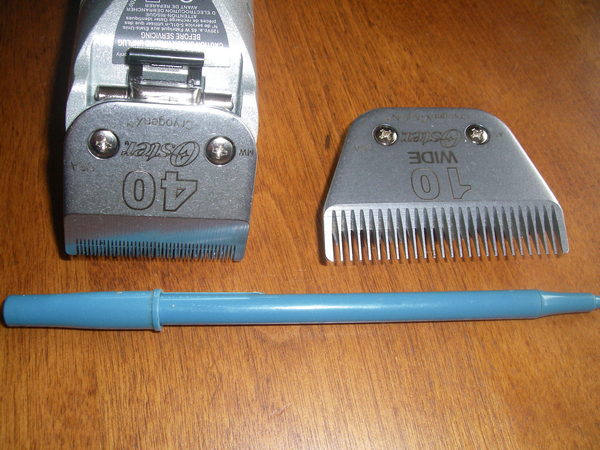 ~
~